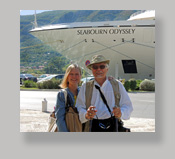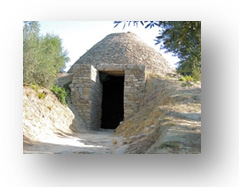 
VENICE | CROATIA | MONTENEGRO | CORFU | KAFALONIA | PYLOS | NAFPLION | PIRAEUS | MILOS | MYKONOS PATMOS | KUSADASI | CHIOS | ISTANBUL DAY 1 | ISTANBUL DAY 2 | ISTANBUL DAY 3 | TRAVEL REFLECTIONS |
 
VENICE | CROATIA | MONTENEGRO | CORFU | KAFALONIA | PYLOS | NAFPLION | PIRAEUS | MILOS | MYKONOS PATMOS | KUSADASI | CHIOS | ISTANBUL DAY 1 | ISTANBUL DAY 2 | ISTANBUL DAY 3 | TRAVEL REFLECTIONS |
PYLOS: A Mycenaen tomb, Nestor's Palace and the Neokastro Castle, 9-27-12
 Our first stop this morning was at an old Mycenae grave site. This one was quite unusual since it is in the shape of a beehive, made out of stone blocks in a dome shape, has withstood over 2,500 years of earthquakes and pillaging, and apparently was a family(not just one person) crypt. Like most of the other structures in these islands, whether old or new, the beehive was surrounded by olive groves. Our guide told us that olive trees are called blessing trees because they provide so many products. It also seems that the bristlecone pine has competition. The guide told us that some olive trees have been dated back thousands of years, and they are still growing and producing new shoots.
As a finale we visited the Neokastro Castle (it looks more like a fort because of the huge surrounding wall). We could see it from the ship and it's situated right above the In more recent times, Pylos is rather central in an event that paved the way for Greek independence. The Battle of Navarino happened in Pylos in 1827 when combined British, French and Russian troops overcame the Turks who were besieging the island. That forced the Turkish Sultan's hand, the Turks left, paving the way for Greek independence. |